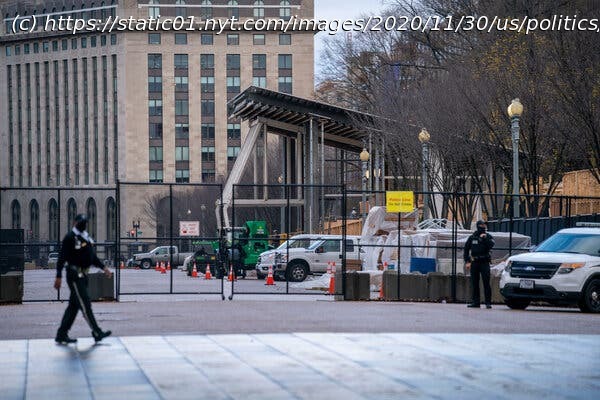Unlike President Trump, who was expected to shrug off health threats in favor of huge crowds, President-elect Joseph R. Biden Jr. has indicated that his inauguration will not be business as usual.
The stage being built on the West Front of the Capitol can hold 1,600 spectators for a close-up view of President-elect Joseph R. Biden Jr. as he takes the oath of office. The reviewing stand under construction in front of the White House will be ready for the inaugural parade and thousands of cheering onlookers as the marchers pass by. And the National Mall is prepared to accommodate many more. But the traditional pomp and circumstance of America’s quadrennial version of a coronation is colliding with the grim reality of a pandemic that is likely to still be raging on Jan.20. For that reason, Mr. Biden’s team is signaling that he wants a very different kind of inauguration. If he had won re-election, President Trump was expected to shrug off the health threats in favor of huge crowds for his inauguration. But Mr. Biden has already indicated that his will not be business as usual. In a statement on Monday, the newly appointed chief executive of Mr. Biden’s inaugural committee hinted at the looming balancing act between health and politics. “We will honor the American inaugural traditions and engage Americans across the country while keeping everybody healthy and safe,” said Tony Allen, the president of Delaware State University and the committee’s chief executive. What could that look like? Aides to the president-elect are being coy. But Mr. Biden’s approach to campaigning during the pandemic — which included drive-in rallies, socially distanced news conferences and a largely virtual national convention — provides a blueprint for how events might be reshaped for the Covid era. On Capitol Hill, where the official inaugural ceremonies are arranged by a bipartisan congressional committee, lawmakers and aides have quietly been at work since long before the election trying to reimagine what a transfer of power during a pandemic might look like. The short answer is: quite a bit less crowded. The organizers are determined that Mr. Biden take the oath of office and deliver an address to the nation outside the West Front of the Capitol, preserving an iconic tableau that has often set the tone for a new presidency. But to make it happen, they are likely to slash the number of officials flanking Mr. Biden. Those who do make the cut — Supreme Court justices, former presidents, top House and Senate leaders and the Joint Chiefs of Staff among them — will be required to socially distance and wear masks. Some may be asked to take coronavirus tests. The most difficult challenge may be keeping away crowds. Congress typically distributes 200,000 tickets for seats near the platform. Senator Roy Blunt, Republican of Missouri, who is overseeing the planning on Capitol Hill, has indicated that number could be cut drastically. Inaugural planners are still debating whether they can salvage a luncheon in National Statuary Hall at the Capitol, where more than 200 dignitaries and guests have feted the new president since the 1950s. They may also alter or cancel a smaller signing ceremony in the ornate President’s Room off the Senate floor. A traditional military review on the East Front of the Capitol, on the other hand, may still go on in some form.
Домой
United States
USA — mix Biden’s Inauguration: Expect Smaller Crowds and More Social Distancing






